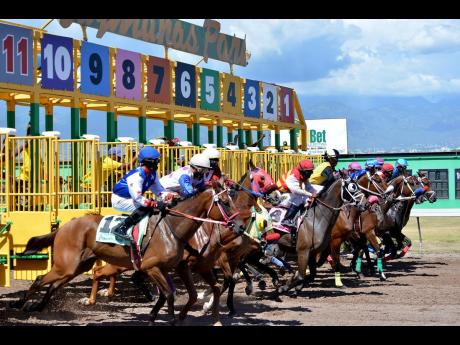Jimmie says | SVREL not getting money’s worth
HORSE RACING, despite its tattered sails, should consider itself the most fortunate ‘sporting’ activity in Jamaica. No other sport even comes close to benefiting from the billions of dollars doled out by successive governments that operated Caymanas Park for close to 40 years, up to 2017, before Supreme Ventures Racing and Entertainment Limited (SVREL) joined the wagon by way of divestment, ridding the country’s coffers of an albatross.
Divestment, however, should have provided the perfect opportunity for SVREL to, without fear or favour, hit the reset button at the 196-acre property, which spent too long being Government-operated, developing a Jamaica Omnibus Service syndrome of entitlement by ‘stakeholders’.
Nothing is wrong with being a stakeholder, except that it does not make one the owner, which remains the major disillusionment among occupational groups at Caymanas Park, albeit four years into divestment. Playing ‘goody-two-shoes new neighbour’, SVREL rang the doorbell with a warm apple pie, a $100 million purse increase in 2017, then watched $607.7 million evaporate within its first 22 months of operation, events that have somewhat escaped the memories of ‘purse increase’ town criers.
SVREL'S BAD START
SVREL started on the wrong foot, stretching one hand with a $100 million purse increase without simultaneously using the other to fix the product for which it was paying, knowing it had inherited a $35.1-million decline in local-racing sales, for 2014-2015, from Caymanas Track Limited.
Thus continues last week’s piece about amending the product that has been offered to breeders, owners, trainers, jockeys, grooms, and the betting public since 1993. Proposed change will be for another column. There is just too much to complain about.
Last week’s piece pointed how difficult it would be to convince someone to be an owner if one were to truthfully explain that after two years and expending approximately $3.2 million, a horse acquired at the Yearling Sale might have to be put up for sale, $550,000, in a claiming race, because that’s the product (system of racing) SVREL has to match the horse’s ability to earn prize money.
The joy of owning a racehorse is watching that animal go to the front in a race and outclass rivals or, even more thrilling, weave its way through the field and get to the line in a head-bob. However, for this to happen, to the viability of all – promoter, breeder, owner, trainer, jockey, groom, and punter - the system of racing must give the horse a fair chance of earning purse money but certainly not at the risk of the owner losing his or her horse.
‘We need new owners’, ‘We need more horses’, yes, but who will be so foolish to join the band of Eskimos at Caymanas Park, selling fast-melting ice to each other? How can a system that forces one to sell his or her horse, to earn purse money, entice new owners or encourage commercial breeders to invest in bloodstock?
If there is a horse sale (claiming races) at Caymanas Park twice weekly, why should commercial farms be anything other than what they have become, holding areas for clients’ mares, and in some cases, stallions? Breeders are now surviving off lodging, becoming equine Airbnbs, instead of investing in quality bloodstock to commercially improve the quality and quantity of racers in what should be a system of racing that is capable of attracting new owners who can afford the sport.
The routine that exists at Caymanas Park, among the majority of trainers, is a dreary one. They have not realised that the system of claiming and condition races reduces them to having to accept their ‘positions’ as footstools, waiting for crumbs to fall from bigger barns, or lining up to repeatedly claim no more than 20 patched-up runners from the lowest and lamest levels of horses, for either themselves or others, most of whom can’t afford to pay the required training fee.
IT'S A HUSTLE
The sad thing is that the routine offers a ‘hustle’. A horse claimed, whether it enters its new barn hopping on three legs or not, immediately becomes a source of income outside of purse money to be earned, 'inside information', or even through remittances from abroad.
A young horse bought at the Yearling Sale or farm has no such value until it is ready to race, possibly a year and a half, hence the preference to hang on to the system of claiming and condition races, yet to the detriment of the entire industry, and themselves.
Jockeys’ incomes are affected because it is the same top three or four riders who scramble to get aboard the best of the worst horses at Caymanas Park, unlike North America, which has many racetracks of different calibres, from which the claiming and conditions system of racing was brought to Jamaica by Chris Armond in 1993.
Grooms have no certainty of tenure or income. A horse claimed today could be gone tomorrow, hence a proliferation of unlicensed persons employed and underpaid by trainers who know they have nobody to complain to while the horses they care for race under the names of one or two grooms who happen to have licences.
The promoter is now suffering. Probably five horses can be considered grade-one runners, drawing the ire of owners and trainers. Three and four-furlong races have become staple, some horses unable to complete the distance.
Experienced punters now focus on jackpots to be won in the Pick 6 and Pick 9, etcetera, which allow them to use multiple selections in bets because the form of runners has become unpredictable due to mostly lame horses, rendering logical reasoning (handicapping) irrelevant, a process that will never attract newcomers to the sport, making horse racing more niche than it already is.
How much longer will SVREL allow the tail to wag the dog?

